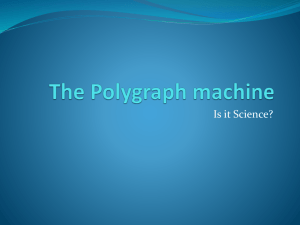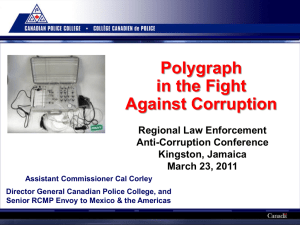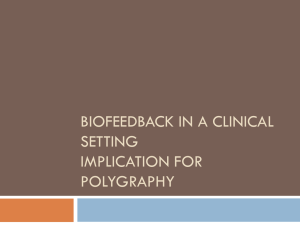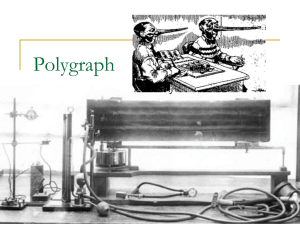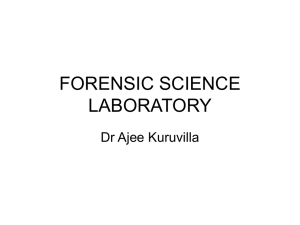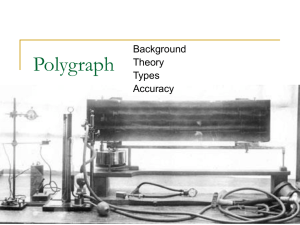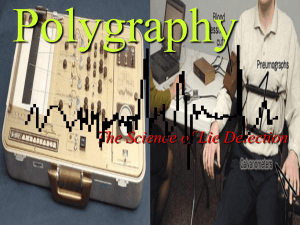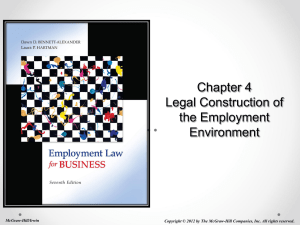Lie Detectors: Infallible Technology or
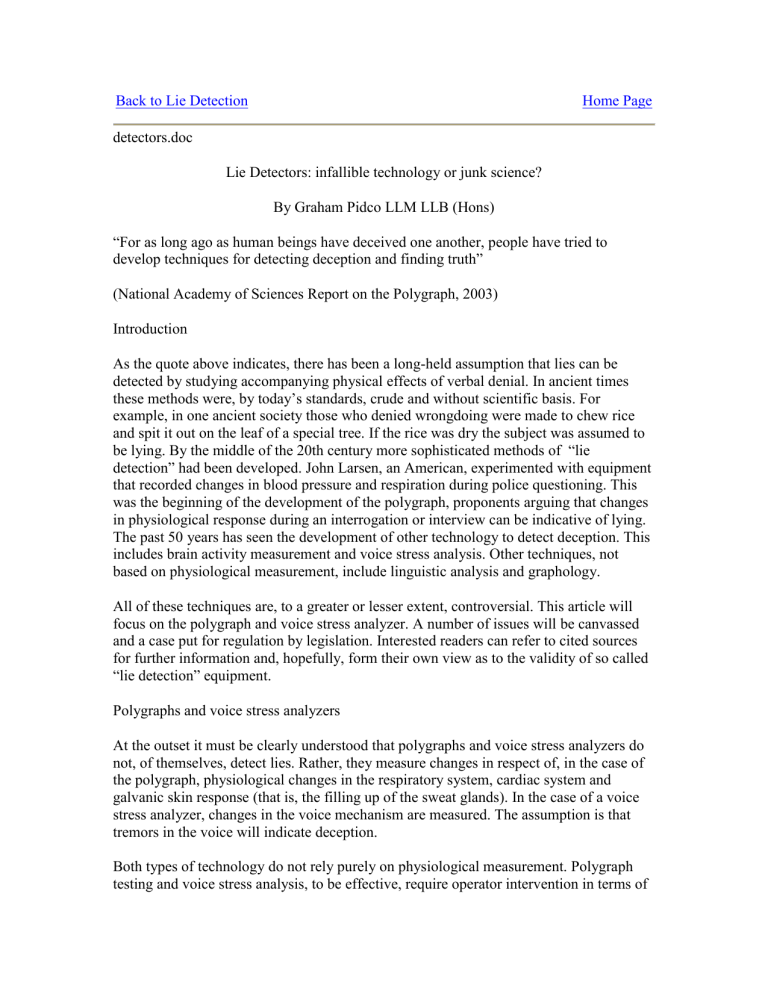
Back to Lie Detection Home Page detectors.doc
Lie Detectors: infallible technology or junk science?
By Graham Pidco LLM LLB (Hons)
“For as long ago as human beings have deceived one another, people have tried to develop techniques for detecting deception and finding truth”
(National Academy of Sciences Report on the Polygraph, 2003)
Introduction
As the quote above indicates, there has been a long-held assumption that lies can be detected by studying accompanying physical effects of verbal denial. In ancient times these methods were, by today’s standards, crude and without scientific basis. For example, in one ancient society those who denied wrongdoing were made to chew rice and spit it out on the leaf of a special tree. If the rice was dry the subject was assumed to be lying. By the middle of the 20th century more sophisticated methods of “lie detection” had been developed. John Larsen, an American, experimented with equipment that recorded changes in blood pressure and respiration during police questioning. This was the beginning of the development of the polygraph, proponents arguing that changes in physiological response during an interrogation or interview can be indicative of lying.
The past 50 years has seen the development of other technology to detect deception. This includes brain activity measurement and voice stress analysis. Other techniques, not based on physiological measurement, include linguistic analysis and graphology.
All of these techniques are, to a greater or lesser extent, controversial. This article will focus on the polygraph and voice stress analyzer. A number of issues will be canvassed and a case put for regulation by legislation. Interested readers can refer to cited sources for further information and, hopefully, form their own view as to the validity of so called
“lie detection” equipment.
Polygraphs and voice stress analyzers
At the outset it must be clearly understood that polygraphs and voice stress analyzers do not, of themselves, detect lies. Rather, they measure changes in respect of, in the case of the polygraph, physiological changes in the respiratory system, cardiac system and galvanic skin response (that is, the filling up of the sweat glands). In the case of a voice stress analyzer, changes in the voice mechanism are measured. The assumption is that tremors in the voice will indicate deception.
Both types of technology do not rely purely on physiological measurement. Polygraph testing and voice stress analysis, to be effective, require operator intervention in terms of
observation of a subject’s body language and interpretation of verbal responses. When assessed in conjunction with changes in physiological condition (polygraph) or voiceprint data (voice analysis) an operator usable to provide an opinion as to whether the subject has displayed signs of being deceptive. Simply put, “lie detection” is not merely interpreting recorded measurements on a graph. Rather, the interpretation of these measurements is based on operator evaluation of verbal and physical cues. A change in blood pressure, for example, does not of itself indicate deception.
Polygraph testing can only be per-formed with the knowledge of the subject. This should be obvious bearing in mind it is necessary for the individual to be “hooked up” with leads that measure physiological responses. In contrast, proponents of voice stress analyzers highlight the fact tests using this equipment can be conducted covertly (i.e. without the knowledge or consent of the subject).
Nevertheless, both types of equipment have one thing in common. Any conclusion reached by an operator is not based purely on objective interpretation of recorded changes in physiology. Rather, the result is very much dependent on the skill, expertise and integrity of the operator.
Use of equipment
The traditional use of polygraphs and other “lie detectors” is in so called specific event investigations. That is where a specific crime has been committed and investigators are attempting to identify the perpetrator or eliminate suspects. Other uses include pre-and post-employment screening where prospective and current employees are tested to ascertain honesty and integrity. Subjects are questioned regarding such things as drugs use and the commission of offences of dishonesty. This type of test-in is controversial and not without its critics. In the United States legislation prohibits private employers from requiring individuals to submit to such testing. However, this prohibition does not necessarily extend to Federal government agencies or law enforcement organizations.
The FBI, Secret Service, CIA and Department of Energy routinely con-duct such tests.
Failure gives grounds to reject an application for employment. In Australia, New South
Wales has enacted legislation similar to that in force in the United States.
In jurisdictions other than New South Wales, commercial organisations have promoted the used of polygraphs for employment screening. According to an article in the Brisbane
Courier Mail a polygraph provider in Queensland has been “hired by employers to scrutinise workers for everything from pre-employment checks to questioning over fraud and theft incidents in the work-place”. A more novel use is proposed in Victoria. It is suggested that paroled sex offenders be required to submit to compulsory polygraph testing in order to deter repeat offending and detect new offences.
It is pertinent to note that the use fore-employment polygraph results based on generalised questioning is subject to criticism. Civil litigation is on foot in the United
States against Federal government agencies who have denied employment on the basis of
“unsubstantiated accusations of deception”.
Accuracy and Reliability
Scientific opinion on the validity of lie detection technology is polarised. Advocates of polygraphs claim an accuracy rate between 97 and 98 percent. A South African evaluation of one particular type of voice stress analyser suggest-ed an accuracy rate of
94 to 98 percent. On the other hand, a not insignificant number of scientists totally reject accuracy and reliability levels of “better than chance”. That is, a percentage of 50 percent. Antipolygraph.org , a private non-profit body based in the United States argues that polygraph testing has no scientific basis. In support of this view the opinions of psychologists are cited, for example, “… the theory and methods of the polygraph are not rocket science, indeed they are not science at all”(Professor David Liken, author of
Tremor in the Blood) and “the so called control question test polygraph is a technological flight of fancy. It is often used as a psychological rubber hose to induce confessions.
Founded on lies, it spreads distrust while posing as the path to truth” (Professor John
Furedy, University of Toronto, Canada). Critics of Voice analysers claim an accuracy and reliability rate of 37 percent.
However, there are those who, whilst conceding polygraph testing (as distinct from voice analysis) may have some validity, express concern at the lack of empirical scientific research inhibiting definite conclusions on reliability. In2003 the National Academy of
Sciences in the United States published the findings of a study of research into the accuracy of deception detection technology when used for pre- and post-employment screening. In the course of the report mention is made of specific event(criminal investigation) testing, the Academy reporting that despite short-comings in the quality of research, it is open to conclude that “in populations of examinees (subjects) … represented in the research literature [and who are]untrained in countermeasures, specific incident polygraph tests can discriminate lying from truth telling well above chance, though well below perfection”. In respect of voice analysers the Academy is less than impressed. It concludes that a decade of research has not provided evidence of superiority over the polygraph. Accordingly, a definite conclusion as to accuracy and reliability is not possible.
It is significant the academy is not prepared to attribute a precise accuracy rate to the polygraph. Perhaps this is not surprising bearing in mind the identified limitations of research studies. However, polygraph advocates cannot gain com-fort from the finding of specific event testing being accurate “well above chance”. This simply means greater than50 percent. But how much above 50percent is more than chance? Is 60 per-cent “well above” or is it 90 percent? We simply do not know.
The Academy is more forthcoming onthe issue of pre and post employmentscreening, concluding Its (polygraph) accuracy in distinguishing actual or potential security violators from innocent test takers is insufficient to justify employee security screening in federal agencies.
In summary, this latest evaluation of polygraph and voice analyser testing fails to definitely establish the reliability and accuracy of testing. While this may be due to a
number of factors, three specific issues must be considered, being (i)operator methodology, (ii) training and(iii) counter measures.
(i) Operator Methodology
Contrary to popular belief the polygraph operator is not simply interpreting changes in physiological condition in response to questions. Part and parcel oaf polygraph test is the operator’s interpretation of the subject’s other physical responses. For example, the operator will take into account the body language of a subject both during a pre-test interview and the actual test. Should the subject fail to maintain eye contact during questioning this might be used in arriving at a conclusion the subject is being deceptive.
Operators of voice stress analysers employ similar techniques.
Unfortunately, the use of body language cues is fraught with inherent dangers. Cultural variables and nuances may not be taken into account. To use the example of eyes contact, in some cultures it is considered impolite to look someone in the face when speaking.
Unless the operator is aware of such cultural influences the risk of an inaccurate finding increases.
Polygraph testing is based on measurement of increased arousal in terms of cardiac, respiratory and galvanic skin changes. If for any reason a subject is aroused beyond the norm prior to taking the test this may affect the conclusions drawn by the operator. If, for example, a suspect for a crime is subjected to vigorous interrogation prior to being tested it is quite possible his/her level of arousal will be above normal and impact on the test. It is for this reason the International Association of Chiefs of Police in its Model Policy for
Polygraph Examinations states “Officers shall not interrogate a subject just before he/she is to take a polygraph”. The author ofthis article is aware of an instance inWestern
Australia where a subject wasput through a length accusatory inter-view shortly prior to undertaking a polygraph examination. The subject’s level of arousal had increased and the result of the polygraph examination islet open to question.
Also, despite the fact polygraph examinations should only be conducted upon individuals who volunteer, is true consent ever obtained? In Canada, a senior law enforcement officer in the province of Alberta has conceded that whilst individuals have the right to refuse a test it is common practice today, “OK, if you’re really telling the truth, prove it to us”.
Leaving aside the legal proposition of innocent until proven guilty, implicit coercion is, according to one researcher in the field, likely to make examinees overly anxious, increasing the likelihood of false positive outcomes”.
Finally, in Australia at least, polygraph and voice stress operators operate in a commercial environment. That is, they’re paid by results. In any commercial venture there is always the possibility of the service provider telling the client what he/she wants to hear. Whilst not unique to the “lie detection industry”, this form of psychological pressure haste potential to result in the destruction of an individual’s reputation. In the
United States, the current affairs pro-gram 60 Minutes set up a business and engaged three polygraph operators totes “suspects” for a crime that had not been committed. Each
“suspect” was reported by the operator to be lying, even though they were actually telling the truth. It is open to speculate whether the pressure to obtain the required result influenced the outcome, or whether the operators were simply inadequately trained. This leads to consideration of the standard of training and expertise that should be required and expected of operators.
(ii) Training
In the United States non-academic poly-graph and voice stress analyser training is conducted by private commercial organisations. The United States Department of
Defense operates a Polygraph Institute that provides training for Federal law enforcement and intelligence personnel. In respect of the private organisations it is unclear what educational and professional pre-requisites are in place to ensure suitability for inclusion in a training course. Some states in the US require certification and licensing, others don’t. In some European countries (eg France) poly-graph training is apparently only avail-able through universities at the post-graduate level. Entry to such courses requires a candidate to possess an under-graduate degree.
To the knowledge of this author most Australian operators have received their training overseas. It is only recently that training courses have been offered in this country. A key issue is the standard of training that is offered and undertaken. In the absence of government regulation, in those states where polygraph and voice analyser testing is permitted it impossible for any individual to purchase the equipment from overseas and hangout his/her “shingle”. There is simply no way of knowing whether or not an operator has been independently assessed as competent.
(iii) Counter Measures
In both specific incident and employment screening situations the National Academy of
Sciences concluded countermeasures by a subject could affect the result of a polygraph test. One former polygraph operator, a Detective Sergeant with the Oklahoma City Police
Department USA, has written a manual on how to “pass” both the polygraph and computer voice stress analyser tests. His motive, aside from the obvious commercial advantage, is said to be his conclusion that “over 50% of honest truthful people are called liars by these machines”.
Antipolygraph.org publishes an electronic book “The Lie Behind the Lie Detector” which can be downloaded free of charge from its web site. A whole chapter is devoted to counter measures designed to protect an individual against a false positive outcome. The first piece of advice is to “Just say No!” However, this may be easier said than done if subject is subtly coerced into “proving he/she is telling the truth”, or, in the case of employment screening, is required by a current or prospective employer to undertake the test. A second suggestion is that the subject be” completely honest” and inform the operator he/she knows how to defeat the test. As is pointed out in the book, the test would still be conducted and the window open for the operator to accuse the subject of having
employed counter-measures. The third option is to become acquainted with the countermeasures, say nothing and take the test.
Countermeasures are of two types. Behavioural counter measures involve the use of body language techniques and appropriate answers to questions put byte operator. Chart recording manipulations involve subtle breathing changes and physical measures such as constricting the sphincter and biting down slowly on the tongue. Space precludes further discussion of specific techniques, however, what is important is the fact research has shown them to be effective. So, how much faith we can place in the polygraph and voice stress analyser? Further, consideration must be given as to whether the “lie detection industry” should be permitted to continue without some form of regulation.
A Need for Regulation?
In respect of employment screening the recent findings of the National Academy of
Sciences on the reliability of poly-graphs points to a need for legislation in Western
Australian similar to that inner South Wales. As pointed out beacon, a member of the
Academy Committee, there is simply no scientific justification for such screening. Tests are, in his view, “the equivalent of playing Russian roulette” and may contribute to the lowering of employee morale. Voice stress analysers create their own regulatory problems. One of their stated advantages over polygraphs is the ability to conduct a test without the subject’s knowledge. A conversation may be recorded with the consent of all parties and comply with the Surveillances Devices Act, but what if without the knowledge of the subject, his/her voices being analysed? It is arguable the law, as it stands, provides no protection from this type of privacy breach.
In respect of specific event testing, arguments can be mounted both for and against a total prohibition on the use of such tests. On the basis of the available research, if polygraph or voice analysis into be utilized as an investigative aid there’s a need for proper regulation.
To this end, legislation should be enacted which:
• Establishes minimum training, qualifications and ongoing professional development;
• Requires investigators and operators to adhere to protocols and procedures laid down in
Regulations;
• Makes it clear that refusal to under-take a test is not, in any way, to adversely reflect on an individual;
• Prohibits law enforcement personnel from using any form of coercion(explicit or implicit) in persuading an individual to undertake a test;
• Places responsibility for testing in an organisation or body independent of the Police
Service
.On the other hand, even legislation that permits testing for investigative purposes may not be sufficient to over-come the lack of certainty in polygraph and voice stress analyser results. In order to avoid investigators falling into the” mind set” that failure to pass a lie detection test is indicative of guilt and lead to possible “process” or “noble cause” corruption, perhaps the legislation should prohibit the use of these devices for any purpose.
Conclusion
No doubt the debate over the validity and accuracy of the technology discussed in the article will continue for years to come. I suggest that the usefulness of these devices be approached with healthy skepticism and one should keep in the back of ones mind the view of the Judges of the United States Supreme Court that “there is simply no consensus that polygraph evidence is reliable”.

